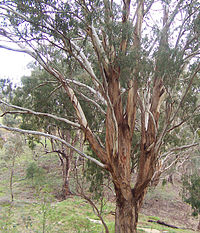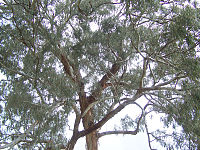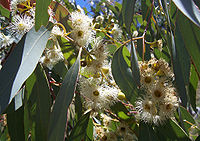Eucalyptus
| Eucalyptus | ||||||||||||
|---|---|---|---|---|---|---|---|---|---|---|---|---|
 | ||||||||||||
| Scientific classification | ||||||||||||
| ||||||||||||
| Species | ||||||||||||
| About 600, see text |
Eucalyptus is a diverse genus of trees (rarely shrubs), the members of which dominate the tree flora of Australia. There are almost 600 species of eucalyptus, mostly native to Australia, with a very small number found in adjacent parts of New Guinea and Indonesia. Eucalypts can be found in almost every part of the continent, adapted to all of Australia's climatic conditions; in fact, no other continent is so characterised by a single genus of tree as Australia is by eucalypts. Many, but far from all, are known as gum trees; other names for various species include mallee, box, ironbark, stringybark, and ash.
All eucalypts are evergreen. Eucalyptus leaves contain an essential oil which is a powerful natural disinfectant, fearsomely toxic in large quantities. Several of the marsupial herbivores, notably Koalas and some possums, are relatively tolerant of it; despite this tolerance, their choice of trees for feeding is still largely based upon sampling the foliage for low toxicity.
On warm days vaporised eucalyptus oil rises above the bush to create the characteristic distant blue haze of the Australian landscape. Eucalyptus oil is highly flammable and bush fires can travel through the oil-rich air of the tree crowns with an explosive power that firefighters can do little about. Eucalypts are well adapted for periodic fires, in fact most species are dependent on it for spread and regeneration: both from reserve buds under the bark, and from fire-germinated seeds sprouting in the ashes.

Eucalypts originated between 35 and 50 million years ago, not long after Australia-New Guinea separated from Gondwana, their rise coinciding with an increase in fossil charcoal deposits (suggesting that fire was a factor even then), but they remained a minor component of the Tertiary rainforest until about 20 million years ago when the gradual drying of the continent and depletion of soil nutrients led to the development of a more open forest type, predominantly Casuarina and Acacia species. With the arrival of the first humans about 50 thousand years ago, fires became much more frequent and the fire-loving eucalypts soon came to account for roughly 70% of Australian forest.
Eucalypts were introduced to the West by Sir Joseph Banks, botanist on the Cook expedition in 1770. The name Eucalyptus means "well-covered"; it describes the bud cap. A small genus of similar trees, Angophora, have also been known since the 18th century. In 1995 new evidence, largely genetic, indicated that some prominent Eucalypt species were actually more closely related to the Angophoras than to the other eucalypts; they were split off into the new genus Corymbia. Although separate, the three groups are allied and it remains acceptable to refer to the members of all three genera, Angophora, Corymbia and Eucalyptus as "eucalypts".
Specimens of the Australian Mountain-ash, Eucalyptus regnans, are among the tallest trees in the world at over 90 metres, making them the tallest of all flowering plants; other taller trees such as the Coast Redwood are all conifers.
Most eucalypts are not tolerant of frost, or only tolerate light frosts down to -3°C to -5°C; the hardiest is the Snow Gum Eucalyptus pauciflora, which is capable of withstanding cold and frost down to about -18°C.
Eucalypts exhibit leaf dimorphism. When young, the leaves are opposite and usually roundish and without petiole. When several years old, the leaves become quite slender and with long petiole. Plants don't flower until adult foliage start to appear, except in E. cinerea.

The Coolibah tree of Waltzing Matilda is a eucalyptus, E. microtheca or E. coolabah.
Fire
Eucalypts regenerate very quickly after fire. After the 2000 Canberra fires, hectares of imported species were killed, whereas in a matter of weeks the gum trees were putting out suckers and looking generally cheerful. Gum trees are also very accomplished at scavenging water at the expense of other plants. In general, they are the feral cats of the arboreal world, and importing them into California was a serious mistake made in the times before governments had discovered ecology.

Eucalypts have a habit of dropping entire branches off as they grow. Eucalyptus forests are littered with dead branches. For this reason, one never sets up camp under an overhanging branch. This may be the real reason behind the drop bear story that one tells one's children - the idea is to keep them out from underneath dangerous branches.
Cultivation and uses
Eucalypts have been introduced to many parts of the world (notably in California, Brazil, Morocco, Portugal, South Africa and Israel) for ornament, timber, firewood and (especially) pulpwood. Several species have become invasive and are causing major problems for local ecologies. In Spain, they have been planted in pulpwood tree farms, replacing native oak woodland. As in other such areas, while the original woodland supports numerous species of native animal life (insects, birds, salamanders, etc.), the eucalyptus groves are inhospitable to such wildlife, leading to silent forests and the decline of wildlife populations.
Eucalyptus oil is readily distilled from the leaves and can be used for cleaning, deodorising, and in very small quantities in food supplements, especially cough drops and decongestants.
